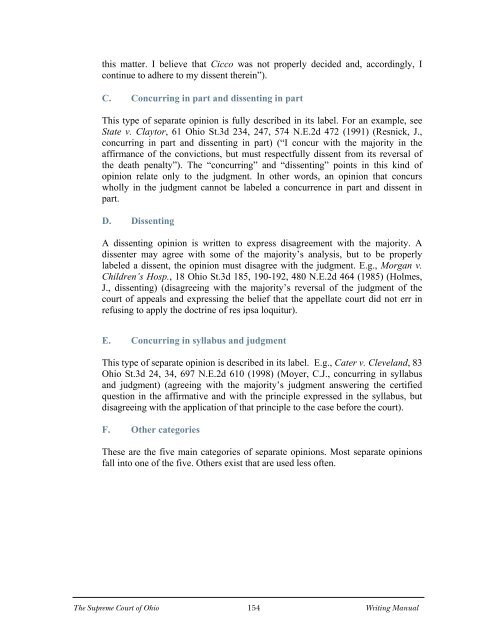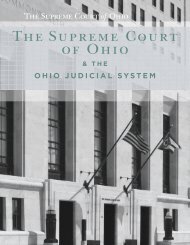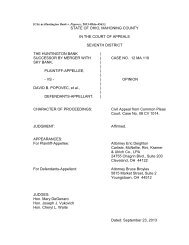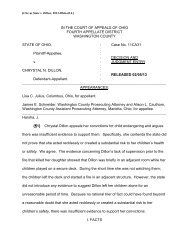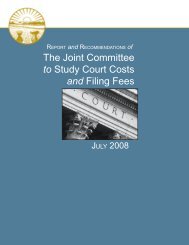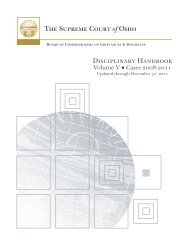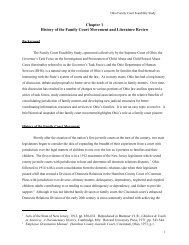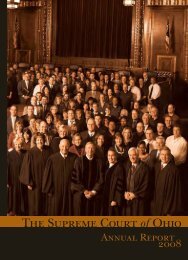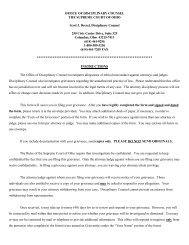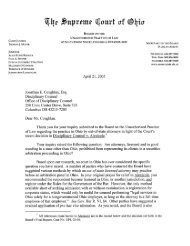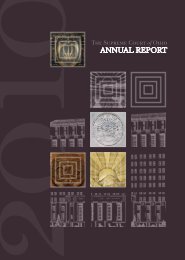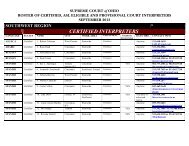this matter. I believe that Cicco was not properly decided and, accordingly, I continue to adhere to my dissent therein”). C. Concurring in part and dissenting in part This type <strong>of</strong> separate opinion is fully described in its label. For an example, see <strong>State</strong> v. Claytor, 61 <strong>Ohio</strong> St.3d 234, 247, 574 N.E.2d 472 (1991) (Resnick, J., concurring in part and dissenting in part) (“I concur with the majority in the affirmance <strong>of</strong> the convictions, but must respectfully dissent from its reversal <strong>of</strong> the death penalty”). The “concurring” and “dissenting” points in this kind <strong>of</strong> opinion relate only to the judgment. In other words, an opinion that concurs wholly in the judgment cannot be labeled a concurrence in part and dissent in part. D. Dissenting A dissenting opinion is written to express disagreement with the majority. A dissenter may agree with some <strong>of</strong> the majority’s analysis, but to be properly labeled a dissent, the opinion must disagree with the judgment. E.g., Morgan v. Children’s Hosp., 18 <strong>Ohio</strong> St.3d 185, 190-192, 480 N.E.2d 464 (1985) (Holmes, J., dissenting) (disagreeing with the majority’s reversal <strong>of</strong> the judgment <strong>of</strong> the court <strong>of</strong> appeals and expressing the belief that the appellate court did not err in refusing to apply the doctrine <strong>of</strong> res ipsa loquitur). E. Concurring in syllabus and judgment This type <strong>of</strong> separate opinion is described in its label. E.g., Cater v. Cleveland, 83 <strong>Ohio</strong> St.3d 24, 34, 697 N.E.2d 610 (1998) (Moyer, C.J., concurring in syllabus and judgment) (agreeing with the majority’s judgment answering the certified question in the affirmative and with the principle expressed in the syllabus, but disagreeing with the application <strong>of</strong> that principle to the case before the court). F. Other categories These are the five main categories <strong>of</strong> separate opinions. Most separate opinions fall into one <strong>of</strong> the five. Others exist that are used less <strong>of</strong>ten. The <strong>Supreme</strong> <strong>Court</strong> <strong>of</strong> <strong>Ohio</strong> 154 Writing Manual
INDEX References are to pages. The letter n after a page number refers to a note on that page. _____________________________________________________ Abbreviations Acronyms, 105 Captions <strong>of</strong> opinions, 109 Citation <strong>of</strong> case, 75-83 Months, 76 <strong>Ohio</strong> reporters, 19-20 Opinions, within text, 105 Out-<strong>of</strong>-state reporters, 29 Out-<strong>of</strong>-state statutes, 44-45 Party references in opinion, 105 Spacing within parentheses in citations, 75 <strong>State</strong>s, 27n Units <strong>of</strong> measurement, 94n West's regional reporters, 35-36 Accord, 65 Acronyms, 105 Administrative Code, <strong>Ohio</strong>, 49 Administrative decisions, <strong>Ohio</strong>, 18 American Jurisprudence, 55 Annotations, 55 Appeals court cases, <strong>Ohio</strong>, 7, 10-11, 14- 16, 21-22 Appellees, definition <strong>of</strong>, 109 Attorney general opinions, <strong>Ohio</strong>, 56 Authorial discretion in judicial opinions, 127 A B Bankruptcy Reports, 25 Block Quotations, 99 But see, 67-68 Capitalization Proper nouns and adjectives, 89 Public <strong>of</strong>fices, agencies, and entities, 90 Titles <strong>of</strong> persons, 89 Captions <strong>of</strong> opinions, 107-110 C Consolidated cases, 110 Cross-appeals, 109 Formal, 107-110 Juveniles, references to, 111 Original actions, 110 Case history, 70-71 Cases, citation <strong>of</strong> Federal, 23-26 Foreign, 37 <strong>Ohio</strong> administrative, 18-19 <strong>Ohio</strong> appeals court, 7, 10-11, 14-16, 21-22 <strong>Ohio</strong> <strong>Supreme</strong> <strong>Court</strong>, 5-6, 13-14, 21- 22 <strong>Ohio</strong> trial court, 11-13, 16-18, 21-22 Out-<strong>of</strong>-state, 26-28 Short form, 59-62 United <strong>State</strong>s <strong>Supreme</strong> <strong>Court</strong>, 23 Cf., 66 Circuit courts, 24 Citation format, recent changes to, 3 Citation(s) omitted, 69-70 Citation <strong>of</strong> <strong>Ohio</strong> cases Appeals court, 7, 10-11, 14-16, 21-22 <strong>Supreme</strong> <strong>Court</strong>, 5-6, 13-14, 21-22 Trial court, 11-13, 16-18, 21-22 Citations Placement within opinion, 72-73 Public domain, 28 Short form, 59-62 Cite-as line, 76, 108-109 Code <strong>of</strong> Federal Regulations, 50 Compare, 66 Compare...with, 67 Concurring opinion, 153-154 Consolidated cases, captions <strong>of</strong>, 110 Constitutions, 39-40 Contra, 67 Corpus Juris, Corpus Juris Secundum, 55 <strong>Court</strong> <strong>of</strong> appeals cases, <strong>Ohio</strong>, 7, 10-11, 14-16, 21-22 Cross-appeals, captions <strong>of</strong>, 109 The <strong>Supreme</strong> <strong>Court</strong> <strong>of</strong> <strong>Ohio</strong> 155 Writing Manual
- Page 1:
The Supreme Court of Ohio WRITING M
- Page 4 and 5:
The Supreme Court of Ohio Style Man
- Page 6 and 7:
1.6. Foreign Cases... .............
- Page 8 and 9:
A. Style ..........................
- Page 10 and 11:
SECTION FOURTEEN: THE CASE CAPTION
- Page 12 and 13:
The Supreme Court of Ohio viii Writ
- Page 14 and 15:
The Supreme Court of Ohio x Writing
- Page 16 and 17:
The Supreme Court of Ohio 2 Writing
- Page 18 and 19:
The Supreme Court of Ohio 4 Writing
- Page 20 and 21:
HOW TO CITE SUPREME COURT OF OHIO C
- Page 22 and 23:
OHIO APPELLATE DISTRICTS MAP The Su
- Page 24 and 25:
HOW TO CITE OHIO COURTS OF APPEALS
- Page 26 and 27:
In citations of trial court opinion
- Page 28 and 29:
HOW TO CITE SUPREME COURT OF OHIO C
- Page 30 and 31:
c. Non-print published cases with n
- Page 32 and 33:
c. Non-print published cases with n
- Page 34 and 35:
ABBREVIATIONS FOR REPORTERS OF OHIO
- Page 36 and 37:
NOTE: For cases decided on or after
- Page 38 and 39:
B. Federal circuit court cases In c
- Page 40 and 41:
In citations of federal district co
- Page 42 and 43:
B. Non-print published For out-of-s
- Page 44 and 45:
ABBREVIATIONS FOR OUT-OF-STATE REPO
- Page 46 and 47:
ABBREVIATIONS FOR OUT-OF-STATE REPO
- Page 48 and 49:
ABBREVIATIONS FOR OUT-OF-STATE REPO
- Page 50 and 51:
ABBREVIATIONS FOR WEST’S REGIONAL
- Page 52 and 53:
The Supreme Court of Ohio 38 Writin
- Page 54 and 55:
2.2. United States Constitution. Wh
- Page 56 and 57:
HOW TO CITE OHIO STATUTES (CONT.) G
- Page 58 and 59:
3.4. Out-of-State Statutes. When ci
- Page 60 and 61:
The Supreme Court of Ohio 46 Writin
- Page 62 and 63:
RULE NAMES AND THEIR ABBREVIATIONS
- Page 64 and 65:
4.5. Federal Regulations. Cite fede
- Page 66 and 67:
HOW TO CITE TEXTS, TREATISES, AND D
- Page 68 and 69:
HOW TO CITE LAW REVIEWS (CONT.) Pou
- Page 70 and 71:
HOW TO CITE ENCYCLOPEDIAS (CONT.) 1
- Page 72 and 73:
The Supreme Court of Ohio 58 Writin
- Page 74 and 75:
HOW TO USE SHORT-FORM CITATIONS WIT
- Page 76 and 77:
HOW TO USE SHORT-FORM CITATIONS FOR
- Page 78 and 79:
HOW TO USE COMMON SIGNALS See Haver
- Page 80 and 81:
HOW TO USE SEE ALSO Because M.B.’
- Page 82 and 83:
HOW TO USE BUT SEE While courts hav
- Page 84 and 85:
HOW TO USE CITATION OMITTED “Usua
- Page 86 and 87:
6.5. Placement of Citation. When de
- Page 88 and 89:
HOW TO USE EMPHASIS SIC The contrac
- Page 90 and 91:
D. Names of months Names of months
- Page 92 and 93:
ABBREVIATIONS IN THE STYLE OR CITAT
- Page 94 and 95:
ABBREVIATIONS IN THE STYLE OR CITAT
- Page 96 and 97:
ABBREVIATIONS IN THE STYLE OR CITAT
- Page 98 and 99:
HOW TO USE ID. (CONT.) (1965). Any
- Page 100 and 101:
The Supreme Court of Ohio 86 Writin
- Page 102 and 103:
The Supreme Court of Ohio 88 Writin
- Page 104 and 105:
7.3. Public Offices, Agencies, and
- Page 106 and 107:
The Supreme Court of Ohio 92 Writin
- Page 108 and 109:
HOW TO USE NUMBERS (CONT.) $1.3 mil
- Page 110 and 111:
The Supreme Court of Ohio 96 Writin
- Page 112 and 113:
WHERE TO PLACE QUOTATION MARKS (CON
- Page 114 and 115:
10.5. Ellipses. Indicate an omissio
- Page 116 and 117:
The Supreme Court of Ohio 102 Writi
- Page 118 and 119: The Supreme Court of Ohio 104 Writi
- Page 120 and 121: The Supreme Court of Ohio 106 Writi
- Page 122 and 123: HOW TO DO FORMAL CAPTIONS FOR AN AP
- Page 124 and 125: C. Original actions When the case i
- Page 126 and 127: The Supreme Court of Ohio 112 Writi
- Page 128 and 129: The Supreme Court of Ohio 114 Writi
- Page 130 and 131: COMMONLY MISUSED WORDS AND PHRASES
- Page 132 and 133: COMMONLY MISUSED WORDS AND PHRASES
- Page 134 and 135: COMMONLY MISUSED WORDS AND PHRASES
- Page 136 and 137: The Supreme Court of Ohio 122 Writi
- Page 138 and 139: The Supreme Court of Ohio 124 Writi
- Page 140 and 141: The Supreme Court of Ohio 126 Writi
- Page 142 and 143: The Supreme Court of Ohio 128 Writi
- Page 144 and 145: OUTLINE OF A JUDICIAL OPINION (CONT
- Page 146 and 147: Example 1—Civil Case, Single Issu
- Page 148 and 149: Conclusion { 10} Because XYZ has de
- Page 150 and 151: II. The Incident and Its Aftermath
- Page 152 and 153: officer was engaged in his official
- Page 154 and 155: Example 3—Civil Case, Multiple Is
- Page 156 and 157: her for over four hours, appellants
- Page 158 and 159: { 20} Appellants cite similar cases
- Page 160 and 161: een available when Jane became agit
- Page 162 and 163: Defense Strategies, 000 Trial Tacti
- Page 164 and 165: HOW TO WRITE GENERAL DISPOSITIONS (
- Page 166 and 167: The Supreme Court of Ohio 152 Writi
- Page 170 and 171: D Dates in text, 91 Dictionaries, 5
- Page 172: S Sample judicial opinions, 131-148


